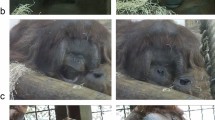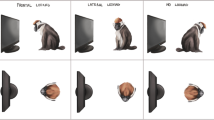Abstract
Contagious yawning is a form of response facilitation found in humans and other primates in which observing a model yawning enhances the chance that the observer will also yawn. Because contagious yawning seems to be more easily triggered when models are conspecifics or have a strong social bond with the observer, it has been proposed that contagious yawning is linked to empathy. A possible way to test this hypothesis is to analyze whether individuals’ responses differ when they observe models yawning or performing different involuntary (i.e., nose wiping, scratching) and voluntary (i.e., hand closing, wrist shaking) actions that are not linked to empathy. In this study, we tested the four great ape species with two different setups by exposing them to a human experimenter repeatedly performing these actions online, and video-recorded conspecifics repeatedly performing these actions on a screen. We examined which behaviors were subject to response facilitation, whether response facilitation was triggered by both human models and video-recorded conspecifics, and whether all species showed evidence of response facilitation. Our results showed that chimpanzees yawned significantly more when and shortly after watching videos of conspecifics (but not humans) yawning than in control conditions, and they did not do so as a response to increased levels of anxiety. For all other behaviors, no species produced more target actions when being exposed to either model than under control conditions. Moreover, the individuals that were more “reactive” when watching yawning videos were not more reactive when exposed to other actions. Since, at least in chimpanzees, (1) subjects only showed response facilitation when they were exposed to yawning and (2) only if models were conspecifics, it appears that contagious yawning is triggered by unique mechanisms and might be linked to empathy.


Similar content being viewed by others
References
Anderson JR, Myowa-Yamakoshi M, Matsuzawa T (2004) Contagious yawning in chimpanzees. Proc R Soc London B 271(Suppl):S468–S470
Armstrong EA (1951) The nature and function of animal mimesis. Bull Anim Behav 9:46–58
Baker KC, Aureli F (1997) Behavioural indicators of anxiety: an empirical test in chimpanzees. Behaviour 134:1031–1050
Braeuer J, Call J, Tomasello M (2005) All great ape species follow gaze to distant locations and around barriers. J Comp Psychol 119:145–154
Byrne RW (1994) The evolution of intelligence In: Slater PJB, Halliday TR (eds) Behaviour and evolution. Cambridge University Press, Cambridge, pp 223–265
Campbell MW, de Waal FBM (2010) Methodological problems in the study of contagious yawning. Front Neurol Neurosci 28:20–127
Campbell MW, de Waal FBM (2011) Ingroup-outgroup bias in contagious yawning by chimpanzees supports link to empathy. PLoS ONE 6(4):e18283. doi:101371/journalpone0018283
Campbell MW, Devyn CJ, Proctor D, Eisenberg ML, de Waal FBM (2009) Computer animation stimulate contagious yawning in chimpanzees. Proc R Soc B 276:4255–4259
Cohen J, Cohen P (1983) Applied multiple regression/correlation analysis for the behavioral sciences. Lawrence Erlbaum Associates Inc., Mahwah
Demuru E, Palagi E (2012) In bonobos yawn contagion is higher among kin and friends. PLoS ONE 7(11):e49613
Gallup GG, Anderson JR, Shillito DJ (2003) The mirror test. In: Bekoff M, Allen C, Burghardt GM (eds) The cognitive animal: empirical and theoretical perspectives on animal cognition. MIT Press, Cambridge, pp 325–333
Harr AL, Gilbert VR, Philipps KA (2009) Do dogs (Canis familiaris) show contagious yawning? Anim Cogn 12:833–837
Hoppitt W, Blackburn L, Laland KN (2007) Response facilitation in the domestic fowl. Anim Behav 73:229–238
Jarvelainen J, Schuermann M, Avikainen S, Hari R (2001) Stronger reactivity of the human primary motor cortex during observation of live rather than video motor acts. NeuroReport 12:3493–3495
Joly-Mascheroni RM, Senju A, Shepherd AJ (2008) Dogs catch human yawns. Biol Lett 4:446–448
Leavens DA, Aureli F, Hopkins WD, Hyatt CW (2001) Effects of cognitive challenge on self-directed behaviors by chimpanzees (Pan troglodytes). Am J Primatol 55:1–14
Maestripieri D, Schino G, Aureli F, Troisi A (1992) A modest proposal: displacement activities as an indicator of emotions in primates. Anim Behav 44:967–979
Nahab FB, Hattori N, Saad ZS, Hallettet M (2009) Contagious yawning and the frontal lobe: an fMRI study. Hum Brain Mapp 30:1744–1751
Napier J (1980) Hands. Allen and Unwin, London
Nishida T, Kano T, Goodall J, McGrew WC, Nakamura M (1999) Ethogram and ethnography of Mahale chimpanzees. Anthropol Sci 107:141–188
Norscia I, Palagi E (2011) Yawn contagion and empathy in Homo sapiens. PLoS ONE 6(12):e28472. doi:101371/journalpone0028472
Nuechterlein GL, Storer RW (1982) The pair-formation displays of the western grebe. Condor 84:350–369
O’Hara SJ, Reeve AV (2010) A test of yawning contagion and emotional connectedness in dogs, Canis familiaris. Anim Behav 81:335–340
Palagi E, Leone A, Mancini G, Ferrari PF (2009) Contagious yawning in gelada baboons as a possible expression of empathy. Proc Natl Acad Sci USA 106:19262–19267
Paukner A, Anderson JR (2006) Video-induced yawning in stumptail macaques (Macaca arctoides). Biol Lett 2:36–38
Platek SM, Critton SR, Myers TE, Gallup GG (2003) Contagious yawning: the role of self-awareness and mental state attribution. Cogn Brain Res 17:223–227
Preston SD, de Waal FBM (2002) Empathy: its ultimate and proximate bases. Behav Brain Sci 25:1–72
Provine RR (1986) Yawning as a stereotyped action pattern and releasing stimulus. Ethol 72:448–455
Provine RR (2005) Yawning. Am Sci 93:532–539
Schino G, Perretta G, Taglioni A, Monaco V, Troisi A (1996) Primate displacement activities as an ethopharmacological model of anxiety. Anxiety 2:186–191
Senju A, Maeda M, Kikuchi Y, Hasegawa T, Tojo Y, Osanai H (2007) Absence of contagious yawning in children with autism spectrum disorder. Biol Lett 22:706–708
Singer T (2006) The neuronal basis and ontogeny of empathy and mind reading: review of literature and implications for future research. Neurosci Biobehav Rev 30:855–863
Wilkinson A, Sebanz N, Mandl I, Huber L (2011) No evidence of contagious yawning in the red-footed tortoise Geochelone carbonaria. Curr Zool 57:477–484
Yoon JMD, Tennie C (2010) Contagious yawning: a reflection of empathy, mimicry, or contagion? Anim Behav 79:e1–e3. doi:01016/janbeh
Zentall TR (2003) Imitation in animals: how do they do it? Curr Dir Psychol Sci 12:91–95
Acknowledgments
This work was funded by a SEDSU project (contract number 012-984 NESTPathfinder), funded by the European Community’s Sixth Framework Programme (FP6/2002–2006). The manuscript was written while Federica Amici held a Humboldt Research Fellowship for Postdoctoral Researchers (Humboldt ID Number 1138999). We thank all the animal keepers at Leipzig Zoo for their endless support and cooperation, Bahar Tuncgenc and Alex Sanchez for coding data for interobserver reliability purposes, and two anonymous reviewers for their very useful comments on a previous version of the manuscript. This study complies with the ethical standards as laid down by the Primate Society of Japan, and was ethically approved by an internal committee at the Max Planck Institute for Evolutionary Anthropology in Leipzig, Germany.
Author information
Authors and Affiliations
Corresponding author
About this article
Cite this article
Amici, F., Aureli, F. & Call, J. Response facilitation in the four great apes: is there a role for empathy?. Primates 55, 113–118 (2014). https://doi.org/10.1007/s10329-013-0375-1
Received:
Accepted:
Published:
Issue Date:
DOI: https://doi.org/10.1007/s10329-013-0375-1




